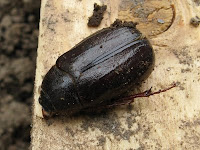That depends of where you live. Growing up in Switzerland, I remember as a small girl 3 or 4 collecting May bugs in the evening (they seem to be nocturnal) with my dad. That was before I was grossed out touching bugs and worms. We collected them in a glass jar. They made a funny sound and smelled strange. Then we let them go again.
 When I arrived in Canada (1975) I noticed that there were no May bugs, but the same kind of bug appeared in June and therefore was called June bug. I just chalked it up to the cooler temperatures in Canada.
When I arrived in Canada (1975) I noticed that there were no May bugs, but the same kind of bug appeared in June and therefore was called June bug. I just chalked it up to the cooler temperatures in Canada.
Fast forward to 2009, the last week of May I noticed that there were bugs flying against my bathroom window at night. They sounded just like June bugs, but it was still May. So I guess with the climate change they have now also turned into May bugs.
Digging in my garden I noticed that the bugs hid during the day in the earth and only come out at night when they are attracted to light and bump against lit up windows. Ok, now that my curiosity was peeked I just had to look them up in Wikipedia.
 June bugs belong to the genus of the New World scarab beetle and the subfamily of Melolonthinae.
June bugs belong to the genus of the New World scarab beetle and the subfamily of Melolonthinae.
European May bugs also belong to the same subfamily (link to German text).
 When I arrived in Canada (1975) I noticed that there were no May bugs, but the same kind of bug appeared in June and therefore was called June bug. I just chalked it up to the cooler temperatures in Canada.
When I arrived in Canada (1975) I noticed that there were no May bugs, but the same kind of bug appeared in June and therefore was called June bug. I just chalked it up to the cooler temperatures in Canada.Fast forward to 2009, the last week of May I noticed that there were bugs flying against my bathroom window at night. They sounded just like June bugs, but it was still May. So I guess with the climate change they have now also turned into May bugs.
Digging in my garden I noticed that the bugs hid during the day in the earth and only come out at night when they are attracted to light and bump against lit up windows. Ok, now that my curiosity was peeked I just had to look them up in Wikipedia.
 June bugs belong to the genus of the New World scarab beetle and the subfamily of Melolonthinae.
June bugs belong to the genus of the New World scarab beetle and the subfamily of Melolonthinae.European May bugs also belong to the same subfamily (link to German text).
June bug larva ->
Comments